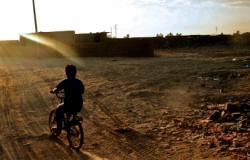Gasoline, Guns, and Giveaways: Is the End of Three-Quarters of Global Poverty Closer than You Think?

Summarising a recent paper written with Chris Hoy, Andy Sumner explores how redistributive policies would be likely to end extreme poverty faster than growth.
Amartya Sen’s famous study of famines found that a nation’s people died not because of a food shortage but because some people lacked entitlements to that food. In a new CGD working paper with Chris Hoy, we ask if a similar situation is now the case for global poverty: are national resources available but not being used to end poverty?
The short answer is yes (but don’t stop reading…). We find that approximately three-quarters of global poverty, at the extreme poverty line of $1.90 per day, if not higher poverty lines, could now be eliminated—in principle—via redistribution of nationally available resources. We argue that the findings provide a rationale for a stronger consideration of some national redistribution for purely instrumental reasons: to reduce or end global poverty faster, rather than waiting years for growth.
Three Key Findings
First, we argue in the paper that global poverty lines ought to be extended beyond $1.90 per day. That’s not too controversial we know. We note that about $2.50 or $5 per day are respectively the approximate value of the average of national poverty lines of all developing countries and the average of national poverty lines of all countries—so a truly global poverty line for the latter. Even those may be insufficient as a World Bank paper points towards a line of $10 per day as the daily consumption associated in longitudinal studies with permanent escape from poverty.
Second, surprisingly, we find that the poor in general live at about the same level. The poor are not necessarily better off if they live in developing countries with higher average incomes or consumption. Indeed, we find for example, the average poor person in extreme poverty in Brazil is actually worse off than in the DR Congo, meaning that the average consumption of a poor person under the $1.90 global poverty line in Brazil is less than the average consumption of a poor person in DR Congo (yes, you read that correctly). The average poor person in Ethiopia is only slightly worse off than the average poor person in China or India.
Third, and this is the controversial bit, it is generally assumed that most, if not all developing countries have insufficient domestic capacity to raise taxes or reallocate public spending to fully address extreme poverty let alone higher poverty lines. In general, this is no longer the case at $1.90 or $2.50 per day and even at $5 per day potentially for much of global poverty. In short, most developing countries have the financial scope to dramatically speed up the end of poverty based on national capacities without necessarily having to wait for economic growth. We find that three-quarters of global poverty could be ended via new taxation and reallocation of public spending (yes you read that right too).
Now the controversial bit. The reallocation of public spending would be away from regressive fossil fuel subsidies which cover for example cheap petrol and largely benefit richer groups in society and towards cash transfers to the poor. We also consider what we call ‘surplus’ military spending and its relocation to cash transfers to the poor. We know this is going to be contentious but we define ‘surplus’ in our paper as ‘more guns than the neighbours,’ meaning annual military spending above the country with the regional lowest per person. If that sounds just too controversial, don’t worry, the regressive fuel subsidies alone would cover seventy percent of global poverty.
In terms of new taxation alone, we find that almost all countries with a GNI Atlas per capita over $2000 per capita could end $1.90 poverty, or even $2.50 poverty.
What happened? Since the beginning of the millennium, high growth rates in many parts of the developing world have not only reduced the number of people living in extreme poverty, but have also significantly increased the number of people who live in a group who aren’t poor. In fact a group who wouldn’t even be poor in the US as they live above the US poverty line. This has created a new capacity for redistribution through the potential to raise taxes. And the next surprise is those taxes aren’t necessarily high. The marginal tax rates would be in the order of 1-2 percent in some populous developing countries like Brazil and China. Again, if this all sounds too radical, just recall the regressive fuel subsidies alone would cover seventy percent of global poverty.
All of the above would suggest one could revisit the classifications of countries by low and middle income in favour of thinking about countries in terms of their capacity to end poverty. This could entail something fairly simple: just double the low income to middle income threshold from approximately $1000 GNI Atlas per capita to about $2000 per capita.
The conclusion of our paper is that these findings demonstrate an instrumental case for redistribution—to ultimately speed up the end of global poverty. Of course the political economy of redistribution would not be easy even if the maths are convincing. The good new is over 100 developing countries already have cash transfer schemes in place so the mechanisms are there in principle to get the cash directly to the poor and the evidence on impact on monetary poverty is compelling.
We think our findings may come as a surprise because the data points towards the fact that the causes of much of global poverty are increasingly a question of national political economy rather than resource scarcity. In fact, that very idea on the shifting causes of much of global poverty is one that I’ve been exploring in a new book out soon but more on that in a future blog.
In short, fiscal policy—and who pays and receives what—is a political choice or contract that governments or elites make with the rest of the population. So if you care about ending global poverty, there is now a case for looking more closely at national redistribution for purely instrumental reasons: to end global poverty quicker than waiting for growth alone to do the job.
In the same way that Amartya Sen’s famous study of famines found that people died from lack of entitlements—and not lack of food availability—our data underscores that while national resources are available to help end poverty, they are not being used for this purpose. Time to ask the question of what matters most: cheap gasoline for the richest groups, more guns than the neighbours, or giveaways to end three-quarters of global poverty?
Andy Sumner is co-director of the King’s International Development Institute at King’s College London, a new institute focused on the emerging economies. Andy is also Global Policy's Deputy Executive Editor. This post first appeared on the CGD's blog.
Photo credit: overgraeme via Foter.com / CC BY


